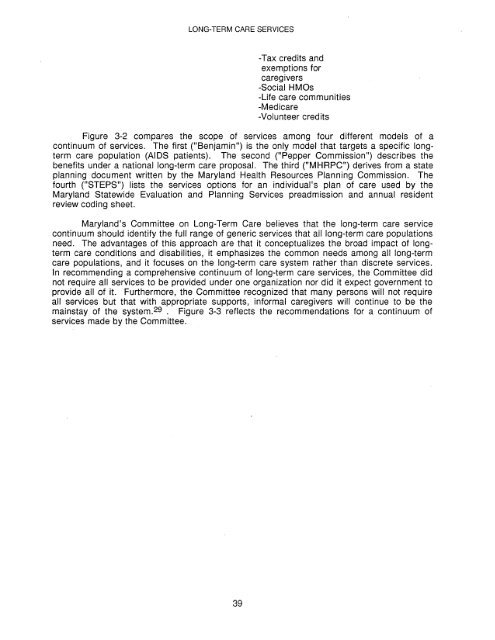long-term care - Legislative Reference Bureau
long-term care - Legislative Reference Bureau
long-term care - Legislative Reference Bureau
You also want an ePaper? Increase the reach of your titles
YUMPU automatically turns print PDFs into web optimized ePapers that Google loves.
LONG-TERM CARE SERVICES<br />
-Tax credits and<br />
exemptions for<br />
<strong>care</strong>givers<br />
-Social HMOs<br />
-Life <strong>care</strong> communities<br />
-Medi<strong>care</strong><br />
-Volunteer credits<br />
Figure 3-2 compares the scope of services among four different models of a<br />
continuum of services. The first ("Benjamin") is the only model that targets a specific <strong>long</strong><strong>term</strong><br />
<strong>care</strong> population (AIDS patients). The second ("Pepper Commission") describes the<br />
benefits under a national <strong>long</strong>-<strong>term</strong> <strong>care</strong> proposal. The third ("MHRPC") derives from a state<br />
planning document written by the Maryland Health Resources Planning Commission. The<br />
fourth ("STEPS") lists the services options for an individual's plan of <strong>care</strong> used by the<br />
Maryland Statewide Evaluation and Planning Services preadmission and annual resident<br />
review coding sheet.<br />
Maryland's Committee on Long-Term Care believes that the <strong>long</strong>-<strong>term</strong> <strong>care</strong> service<br />
continuum should identify the full range of generic services that all <strong>long</strong>-<strong>term</strong> <strong>care</strong> populations<br />
need. The advantages of this approach are that it conceptualizes the broad impact of <strong>long</strong><strong>term</strong><br />
<strong>care</strong> conditions and disabilities, it emphasizes the common needs among all <strong>long</strong>-<strong>term</strong><br />
<strong>care</strong> populations, and it focuses on the <strong>long</strong>-<strong>term</strong> <strong>care</strong> system rather than discrete services.<br />
In recommending a comprehensive continuum of <strong>long</strong>-<strong>term</strong> <strong>care</strong> services, the Committee did<br />
not require all services to be provided under one organization nor did it expect government to<br />
provide all of it. Furthermore, the Committee recognized that many persons will not require<br />
all services but that with appropriate supports, informal <strong>care</strong>givers will continue to be the<br />
mainstay of the system. 29 . Figure 3-3 reflects the recommendations for a continuum of<br />
services made by the Committee.<br />
39
















